Open Philanthropy’s Global Health and Wellbeing team continues to investigate potential areas for grantmaking. One of those is education in poorer countries. These countries have massively expanded schooling in the last half century. but many of their students lack minimal numeracy and literacy.
To support the team’s assessment of the scope for doing good through education, I reviewed prominent research on the effect of schooling on how much children earn after they grow up. Here, I will describe my reanalysis of a study published by Esther Duflo in 2001. It finds that a big primary schooling expansion in Indonesia in the 1970s caused boys to go to school more — by 0.25–0.40 years on average over their childhoods — and boosted their wages as young adults, by 6.8–10.6% per extra year of schooling. I reproduced the original findings, introduced some technical changes, ran fresh tests, and thought hard about what is generating the patterns in the data. I wound up skeptical that the paper made its case. I think building primary schools probably led more kids to finish primary school (which is not a given in poor regions of a poor country). I’m less sure that it lifted pay in adulthood. Key points behind this conclusion:
- The study’s “margins of error” — the indications of uncertainty — are too narrow. The reasons are several and technical. I hold this view mostly because, in the 21 years since the study was published, economists including Duflo have improved collective understanding of how to estimate uncertainty in these kinds of studies.
- The reported impact on wages does not clearly persist through life, at least according to a method I constructed to look for a statistical fingerprint of the school-building campaign.
- Under the study’s methods, normal patterns in Indonesian pay scales and the allocation of school funding can generate the appearance of an impact even if there was none.
- Switching to a modern method which filters out that mirage also erases the statistical results of the study.
My full report is here. Data and code (to the extent shareable) are here.
Background
The Indonesia study started out as the first chapter of Esther Duflo’s Ph.D. thesis in 1999. It appeared in final form in the prestigious American Economic Review in 2001, which marked Duflo as a rising star. Within economics, the paper was emblematic of an ascendant emphasis on exploiting natural experiments in order to identify cause and effect (think Freakonomics). Here, the natural experiment was a sudden campaign to build tens of thousands of three-room schoolhouses across Indonesia. The country’s dictator, Suharto, launched the big push with a Presidential Instruction (Instruksi Presiden, or Inpres) in late 1973, soon after the first global oil shock sent revenue pouring into the nation’s treasury. I suspect that Suharto wanted not only to improve the lot of the poor, but also to consolidate the control of his government — which had come to power through a bloody coup in 1967 — over the ethnically fractious population of the far-flung and colonially constructed nation. I live near the Library of Congress, so I biked over there to peruse a copy of that 1973 presidential instruction. It reminded me of James Scott’s Seeing Like a State, which is about how public bureaucracies impose homogenizing paradigms on the polities they strive to control. After the legal text come neat tables decreeing how many schools are to be built in each regency. (Regencies are the second-level administrative unit in Indonesia, below provinces.) After the tables come pages of architectural plans, like the one at the top of this post.
The instruction even specifies the design of the easels, chairs, and desks. Here’s a desk:

Sure enough, if you search Google images for “Inpres Sekolah Dasar” (Inpres primary school), you’ll find those schools and those desks (source):
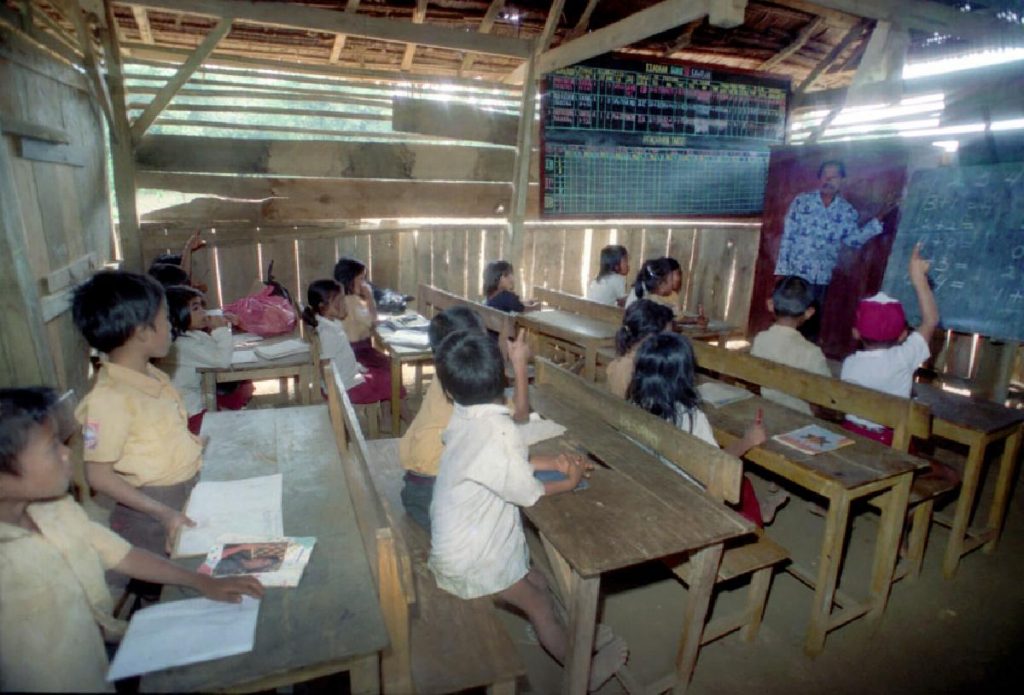
The Inpres campaign doubled the stock of primary schools in the country in just six years.[1] Economists call that a “schooling shock”.
Methods and results
The Duflo study looks for reverberations of this educational earthquake in data from a household survey that the Indonesian government fielded in 1995. By 1995, the first kids who went to the new schools had grown up and started working. The study examines whether boys with more opportunity to attend a new school, by virtue of how young they were and where they lived, actually went to school more and then earned more.[2]
To perform this calculation, the study takes difference-in-differences. It looks not at whether men from regencies that got more schools earned more—a difference—but whether the pay differential between young and old men in 1995 was narrower for natives of regencies that got more schools, which is a difference in differences.[3]
Why look at that? Regencies ranged along a spectrum in how many new schools they got per child. To understand the study’s theory of measurement, I like to split the spectrum into regencies that got fewer schools and those that got more. If the Inpres schools did increase future pay, here’s how the world would look in this framing. In reading this table, bear in mind that it is normal for older workers to earn more than younger ones, as I’ll document later. So if something bumps up the pay of younger workers, it narrows the old-young pay gap:
| Regencies getting fewer schools per child in 1970s | Regencies getting more schools per child in 1970s |
| Older natives too old to have gone to new schools | Older natives too old to have gone to new schools |
| Fewer young natives could have gone to the schools | More young natives could have gone to the schools |
| Fewer young natives get pay boost in adulthood | More young natives get pay boost in adulthood |
| Larger old-young pay gap among natives in 1995 | Smaller old-young pay gap among natives in 1995 |
| Regencies getting fewer schools per child in 1970s | Regencies getting more schools per child in 1970s |
The bottom line (as it were): natives of places that got more schools in the 1970s would exhibit a smaller old-young pay gap in 1995. That is the correlation that the Duflo study looks for…
…and finds. The study (Table 4, panel A) calculates that each additional planned Inpres school, per 1,000 children in a regency, increased boys’ future wage earnings by about 1.5%. The 1.5% number pertains to employees, meaning people who work for other people. (The government surveyors in 1995 didn’t ask self-employed people, including farmers, how much they earned, so they fall out of this analysis.)
In the same way, it is calculated that during childhood those future workers spent a fifth of a year more in school for each Inpres school built per 1,000 children. I think of that finding as an extra year in school for every fifth boy.
If an extra fifth of a year of schooling bumped wages by an average of 1.5%, then a full year would have increased them by about 5 × 1.5% = 7.5%.
Association and causation
That 7.5% payoff rate for a year in the classroom is known as the “return to schooling”. Economists have estimated it thousands of times using data from various contexts. Yet among all those estimates, Duflo’s stands out. It comes from the developing world, which is where most people live. It comes from a big schooling expansion, which adds realism if you’re interested in national-level education policy. And the use of difference-in-differences gives the study a certain rigor, for it rules out some potential critiques. Few other studies can check all those boxes (though some can — see this from Kenya or this from India).
To expand on that last strength: If the Duflo study had only computed differences, then, for example, a simple finding that men from regencies that got more schools earned more, if presented as evidence of impact, could be easily challenged. Maybe everything just costs more — and everyone earns more — in the megalopolis of Jakarta; and maybe Jakarta, as the capital, got more schools per capita. Then we would not need to believe that Inpres schools made a difference in order to explain why men from regencies that got more schools earned more. On the other hand, if urban inflation raised everyone’s wages within Jakarta the same amount, then the old-young pay gap would be the same in Jakarta and beyond. It would not be misleadingly associated with the number of schools each district got. And that, as I said, is what the Duflo study actually checks.
Notice that “if urban inflation…” in the previous paragraph. Despite the rigor of difference-in-differences, you still need to assume something nontrivial about the world in order to fully buy the study’s findings.
Fortunately, the Duflo analysis contains a potentially more compelling basis for proving impact. It has to do with timing.[4] Think of the opportunity to go to one of the new Inpres schools as a medicine. The dose of educational opportunity depended on kids’ ages. Approximately speaking, those 12 and up in 1974 were too old to get any of this schoolhouse-shaped drug, for they had aged out before any new schools got built. Kids who were 11 in in 1974 could get a one-year dose before aging out, at least if they lived near one of the new schools. Kids who were 10 could get a two-year dose. And so on. Because every year more neighborhoods and villages got new schools, well into the 1980s, the average schooling opportunity continued rising for younger and younger kids.
So the graph of Inpres schooling opportunity looks like this:
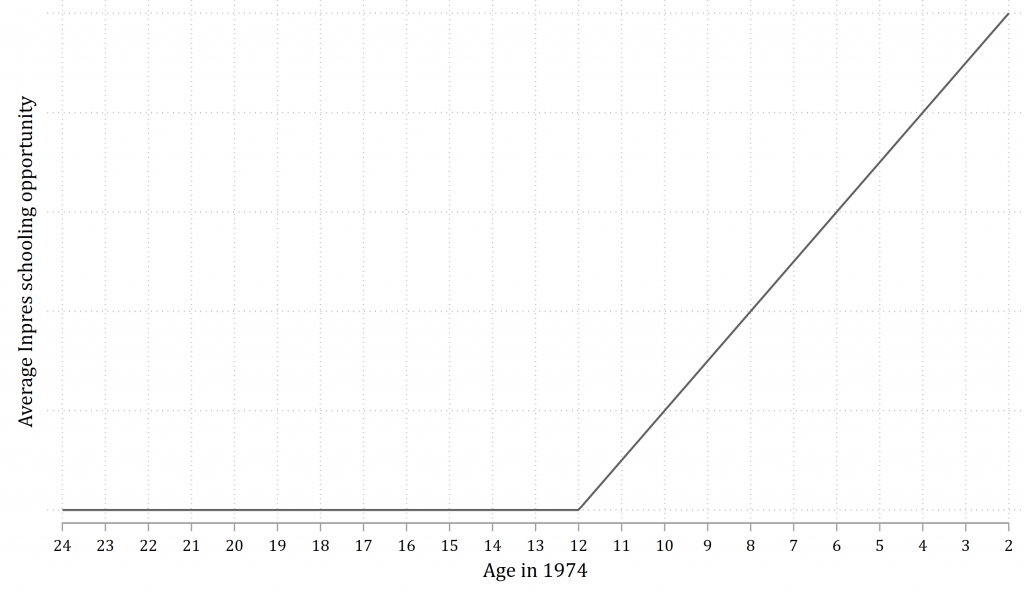
If we found a similar bend around age 12 in other data, such as on earnings in 1995, that would look like the fingerprint of Inpres carrying through, from cause to effect. And that is exactly what the Duflo study suggests happened, if with statistical noise. This graph is from the study: 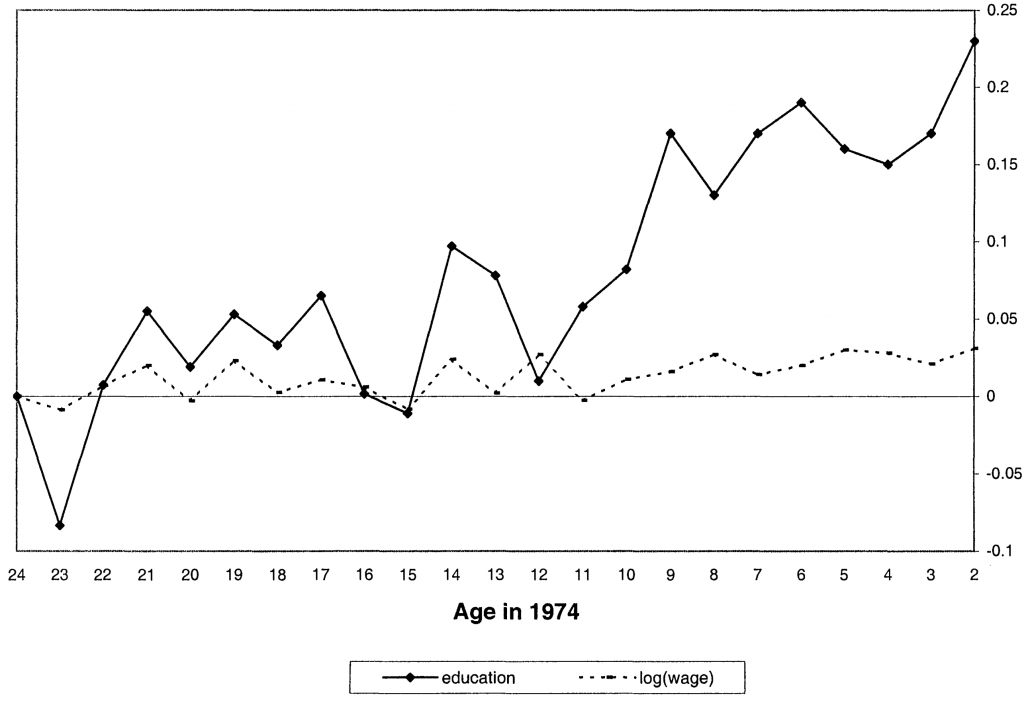
Each dot in this graph is a measurement of the association framed in that table I showed above, between the old-young gap in schooling or pay and how many schools a regency was to receive per child. In that framing, we expect no association for the oldest men in the study, for all were too old to have gone to the new schools. But it should start to emerge—the dots should start to rise—as we scan to men who were 12 or younger in 1974. Duflo wrote:
These coefficients fluctuate around 0 until age 12 and start increasing after age 12. As expected, the program had no effect on the education of cohorts not exposed to it, and it had a positive effect on the education of younger cohorts.
Looking at that graph I wondered: do the trends really bend around age 12? Or should they be seen as straight? Because of the noise, neither characterization completely nails it; the question is whether one model clearly out-fits the other. If the overall trends were straight and long-term, perhaps they had little to do with Inpres. Just as in my reanalyses of Hoyt Bleakley’s studies of hookworm and malaria eradication, I set out to probe this question with a mathematical test.
Starting the reanalysis
I started my quest with a request for the study’s data and computer code. Ironically, Duflo is now the editor of the journal that published her paper. That puts her in charge of enforcing the data and code-sharing policy that applied to her study. Sure enough, she promptly sent me files for reproducing most of the results.[5]
Once I had anchored myself in exact reproduction, I made changes to the code. Most owe to the passage of time: methods in empirical economics have improved since 2001, and Indonesian men of the generation in the Duflo study have continued tracing their way through life (and through government survey data).
While my biggest question going in was about timing, I stumbled on another first-order issue: an alternative explanation for the numerical findings.
I’ll explain a few technical concerns first, as non-technically as I can, then move to that alternative explanation and the search for bends in trends.
Data corrections
Some numbers in the Duflo study come from government documents published in the 1970—presidential instructions and reports on Indonesia’s 1971 census. At the Library of Congress, I scanned pages in these books and double-checked the numbers Duflo sent me. In my experience, it is normal for such a check to expose errors, and normal for them not to affect conclusions much—as happened here. For about a tenth of regencies, my figures for planned schools per 1,000 children differ from Duflo’s. (See my Github repo.)
Clustering
It’s a truism that the larger your sample, the more precise your statistics. The margin of error is tighter if you poll 1,000 people than if you poll 10. But margins of error must themselves be estimated, and determining the effective sample size for this purpose is often a head-scratcher. Should we view a study of the impact of state air pollution rules on asthma rates as being about 50 states or, say, 50 million people? The answer can radically affect how precise we take the results to be. One rule of thumb: the effective sample size is the number of treatment units. There are 50 states, with 50 air pollution laws, so 50 is your number, not 50 million.
In a striking turnabout, soon after finalizing the Indonesia study, Duflo coauthored a paper raising doubts about the methods she had just used: “How Much Should We Trust Differences-in-Differences Estimates?” This new paper was not purely destructive, for it demonstrated the value of a particular mathematical correction, called clustering, which allows one to crunch data on millions of individuals while computing margins of error as if the sample is much smaller. Under the influence of that paper, in returning to the Indonesia study, I cluster standard errors by regency. This widens confidence ranges by a factor of two or three.
Overrepresentation of wealthy families
Governments run many surveys — to track how much people work, how healthy they are, how much they pay for housing, etc. Some surveys are censuses, which ideally entail knocking on everyone‘s door, and even reaching the people who don’t have doors. But finding all those people, asking them lots of questions, and collating the answers all costs money. This is why most surveys, like polls, take samples.
As soon as one gives up on surveying everyone, the question arises: what is the best way to allocate surveying resources to get the most accurate statistical picture? Often, it is not to take a plain random sample, as when pollsters dial random phone numbers. It can be better to split the sample into strata — urban and rural, rich and poor. If some strata are known from censuses to be more homogeneous, then governments can get more precision for the money by sampling those strata less and others more. In a history of one of Indonesia’s national surveys, Parjung Surbakti explains it well:
The fact that an orange taken from a truckload of oranges all coming from the same orchard is sweet, gives adequate evidence to conclude that all the oranges in the truck are sweet. In this example, a very small sample size can provide an accurate conclusion about a large population when the population is homogeneous. It would be a different story if the oranges came from a number of orchards and consisted of different varieties. Then a sample of size 10 might not give as accurate a conclusion as that of the previous example. However, if the truckload of oranges can be sorted by varieties, i.e., the population is stratified, then sampling once again may be made more efficient.
It seems that in Indonesia, poorer people are thought to be more like oranges from the same orchard. For the government surveyors disproportionately visit wealthy households, where wealth is indicated by possessions such as toilets and diplomas.
The Indonesia survey data used in the Duflo study are accompanied by weights to document the oversampling of some groups. They indicate, say, that each surveyed household with a toilet stands for 100 others while each without stands for 200. However, the Duflo study mostly does not incorporate these weights.[6] As a result, wealthier people are overrepresented.
Whether such weights should in general be factored in is a confusing question, so much so that three respected economists wrote “What Are We Weighting For?” to dispel their colleagues’ befuddlement. Here, my concern is that the data are being tilted on the basis of the outcomes of interest. People with more education and higher incomes were more likely to get a knock on the door from a surveyor in 1995 and thus to appear in the Duflo analysis. Imagine a study of the impact of smoking in which people who live are oversampled at the expense of people who die. That would make smoking look safer than it is.
That is why I prefer to incorporate the weights in the Indonesia analysis. For technical reasons, this not only shifts the impact estimates, but further widens margins of error.[7]
Instability of ratios
I quoted the estimate that the Inpres campaign raised wages by 7.5% per year of extra schooling. That is a ratio: a 1.5% wage boost divided by 0.2 years (a fifth of a year) of extra schooling. Because the numbers going into the ratio are themselves averages from samples of Indonesians, each comes with its own margin of error. The true value of the schooling increase in the full population might be 0.3 years or 0.1 years — or 0.0. And if, as far as the math goes, there’s a nontrivial chance that Inpres led to zero additional years of schooling, then there’s a nontrivial chance that the ratio of wage increase to schooling increase is infinite.
The point is not that I think the return to schooling could be infinity (or negative infinity), but that ratios emerging from this sort of analysis can range wildly. Standard methods for computing margins of error can underestimate this uncertainty.
Since Duflo wrote about Indonesia, economists have made a lot of progress in recognizing and working around this devil in the details, which is called “weak identification”. In my reanalysis, I marshal a modern method called the wild-bootstrapped Anderson-Rubin test, which happens to be performed by a cool program I wrote. Like the clustering and weighting corrections, the new method widens the uncertainty bands around the estimated return to schooling.
Bottom line after incorporating the technical comments
After I fix data errors, cluster, and compensate for the oversampling of wealthy households, it is surprisingly unclear whether Inpres caused boys to spend any more time in school. And because dividing by a number that is hard to distinguish from zero produces unstable results, the impact on wages per extra year in school is even less clear. Where Duflo brackets that 7.5% schooling return rate with a 95% confidence range of 1–15%, I widen to a huge span, –44% to +164%.[8]
To be fair, that wide range can mislead. My 70% confidence range is 0–23%. I conclude that incorporating the technical comments into the core Duflo analysis leaves it weakly favoring the view that Inpres-stimulated schooling raised wages.
The alternative explanation: wage scale dilation
As I wrangled with those technicalities and worked to answer my original question about trend bending, I discovered another reason to doubt the Duflo study’s results. And once I did, I realized that Clément de Chaisemartin and Xavier D’Haultfœuille had already pointed to the heart of the issue. It turns out that some more mundane patterns in the data, when fed into the difference-in-differences machine, can produce the same statistical results.
Here are some universal truths, or at least as close as you get to that in economics:
- Those who go to school more earn more, on average.
- The earnings gap between the more- and less-schooled rises with age.
As an example of the second point, in the 1995 Indonesia data, the average employed, college-educated 21-year-old man earned 744 rupiah per hour, only 18% more than the 633 rupiah earned by a contemporary who dropped out of school before fourth grade. But at age 61, in the same data, the hourly pay for the primary school dropout was basically unchanged, 642 rupiah, while pay for the college graduate was more than six times higher than at age 21, at 4,852 rupiah.
This graph shows more fully how the wage scale widened with age among employed Indonesian men in 1995:
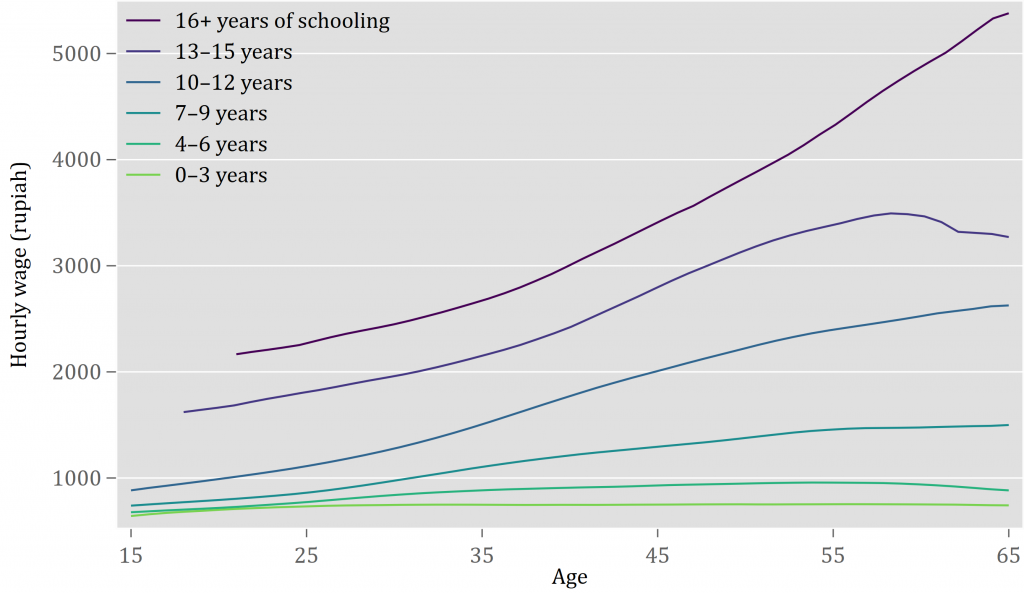
I imagine the people behind the bottom curve as farm workers whose pay had little to do with age. And I imagine that the top curve traces how the elite ascend the ranks of big corporations and government.
The widening of the wage scale feeds into the Duflo study in a mind-bending way. Suppose (correctly) that poorer regencies — the ones that produced more day laborers and fewer doctors and lawyers — received more Inpres schooling funding per child. Then we would see:
| Regencies getting fewer schools per child in the 1970s | Regencies getting more schools per child in the 1970s |
| Natives better off on average | Natives poorer on average |
| More kids grow up to be CEOs | More kids grow up to be day laborers |
| Average pay rises a lot during career | Average pay rises little during career |
| Larger old-young pay gap among natives in 1995 | Smaller old-young pay gap among natives in 1995 |
This table starts and ends in the same places as the earlier table: getting more schools means a smaller old-young pay gap. But it goes by a different route. Nowhere does the new scenario assume or require that the Inpres school-building campaign had any effect.[9] Thus, the study’s methods could lead to the conclusion that Inpres schools raised wages even if they did not.
You might push back against my skepticism: I’m undercutting an argument that schooling increases earnings by invoking the universal truth, confirmed in the graph above, that pay and education go hand in hand — which itself seems like powerful evidence that education increases earnings!
To which I reply: The Duflo study strives not merely to prove that education raises wages, but to measure the impact more sharply. It invokes a natural experiment to remove sources of statistical bias, such as my urban inflation hypothetical. It matters whether the natural experiment is working as intended.
Fresh findings
To probe whether wage scale dilation is generating the Duflo study’s results — and to return to the search for bent trends — I pursued three strategies:
- As foreshadowed, I tested mathematically whether the trend really bends in that Duflo graph I showed earlier. The wage scale dilation theory amplifies the importance of this check: I have no reason to think that wage scale dilation suddenly kicks in at a particular age, so a clear bend in the trend of emergence of those differences-in-differences would favor the Duflo explanation as laid out in that first table above.
- I deployed a newer statistical method called changes-in-changes, which should be immune to wage scale dilation.
- I followed up later on the same generation of Indonesian men, in data from 2005, 2010, and 2013–14 (a selection dictated by whether the surveys asked the needed questions and whether the answers are publicly available). One reason was to see whether the reported link between schooling and earnings was consistent over men’s careers, or a one-off in 1995.
To convey the results, I’ll show you some graphs. All are constructed like that Duflo graph I showed before. But I’ve incorporated the technical fixes, such as correcting data errors, and added some visual elements.
First comes my update of the “education” contour in the Duflo graph. Again, a precise statement of the meaning of the dots — blue in mine, black in the Duflo graph — is a mouthful. Each shows how much the old-young gap in total years spent in school, among men of a particular age, was associated with how intense the Inpres program was in their home regency.[10] Around the dots I added gray bands to depict 95% confidence intervals.[11] They remind us that because of noise in the data, each dot could have landed a bit lower or higher than it does. And I fit a line to the data, in red, while allowing it to kink at age 12: 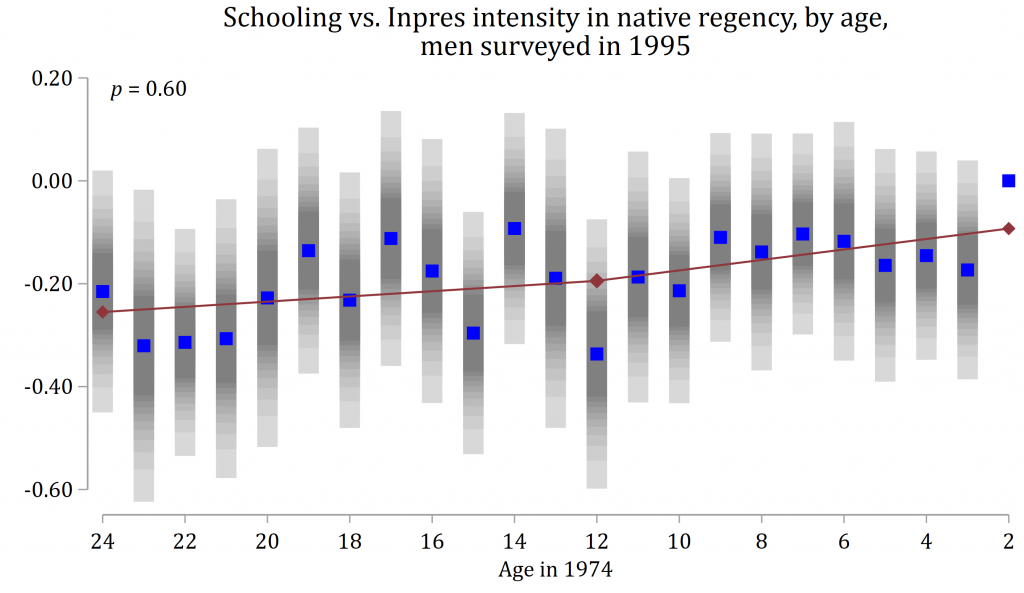
The schooling trend hardly bends. From the standpoint of this search for the fingerprint, it’s not clear that building Inpres schools contributed to rising school attendance. A statistical test for whether the slopes of the two red segments differ returns a p-value of 0.60, which I printed in the upper left. That high probability means that a bend this small could easily have happened by chance, because of statistical noise, if the true line did not bend at all.[12]
Now, the Inpres program built primary schools. So did it at least get more kids to finish primary school? Quite possibly. In the next graph, the vertical axis pertains to the share of workers in 1995 who had finished primary school rather than the total years they spent in school. Now the trend more clearly accelerates around age 12. The p-value for the bend is reassuringly low, at 0.01: 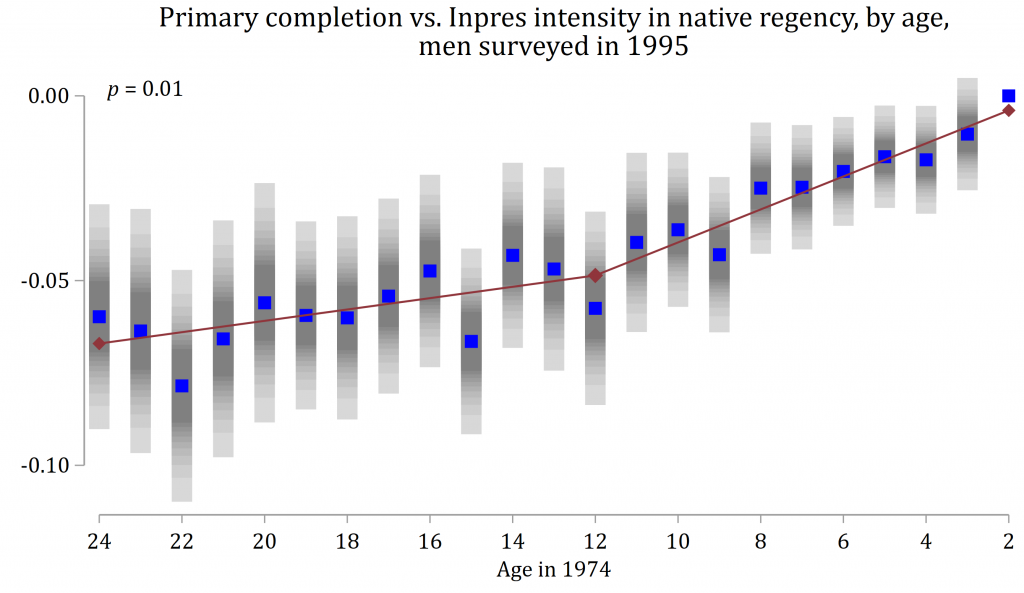
It’s a strange pair of findings: boys finished primary school more but didn’t go to school more? I think the first finding is closer to the truth. The surveyors in 1995 didn’t actually ask people how many years they went to school, but rather the highest grade they attended. Probably, when the schools were first built, some kids who were officially too old to attend them went anyway, rather than going to junior high schools farther away.[13] Even if they spent exactly the same number of years in school, the study would have coded them as having spent fewer, since on paper they only got as far as sixth grade rather than seventh or eighth.[14]
If Inpres at least got more boys through primary school, did that suffice to raise their pay in adulthood? The next graph gets at that possibility by switching the vertical axis to wages. Again, the trend bends up, with a reassuringly low p-value:
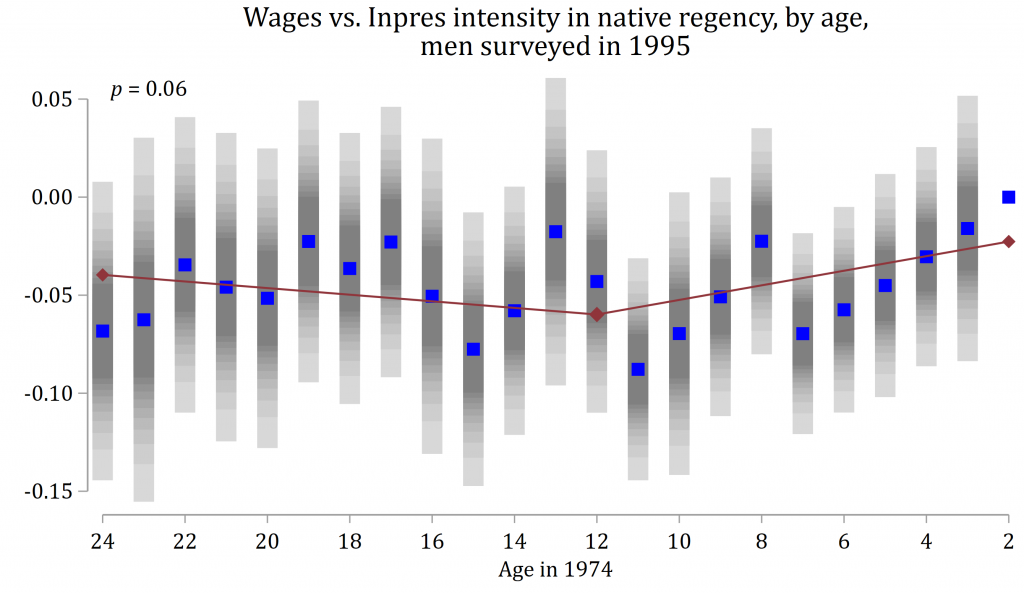
If we assume that the deflection in the primary schooling trend caused the deflection in the wage trend, then we can divide the second by the first to gauge the rate of impact. Unfortunately, the first (the increase in primary school completion) still does not differ from zero with enough certainty to stabilize the ratio. In my paper (Table 7, panel B, column 2) I calculate that finishing primary school changed wages in adulthood by somewhere between –12% and +∞, as a 95% confidence range.[15]
Another source of doubt: when I checked on the same generation of men later in life, the upward bend in the wage trend didn’t persist as strongly. In 2005 (when the men aged 2–24 in 1974 had reached ages 33–55) and 2010 (ages 38–60), the line bends slightly downward.[16] In 2013–14 (ages 41–64), it bends more significantly upward. Rather than showing you all of those here, I’ll average them in a single graph;[17] 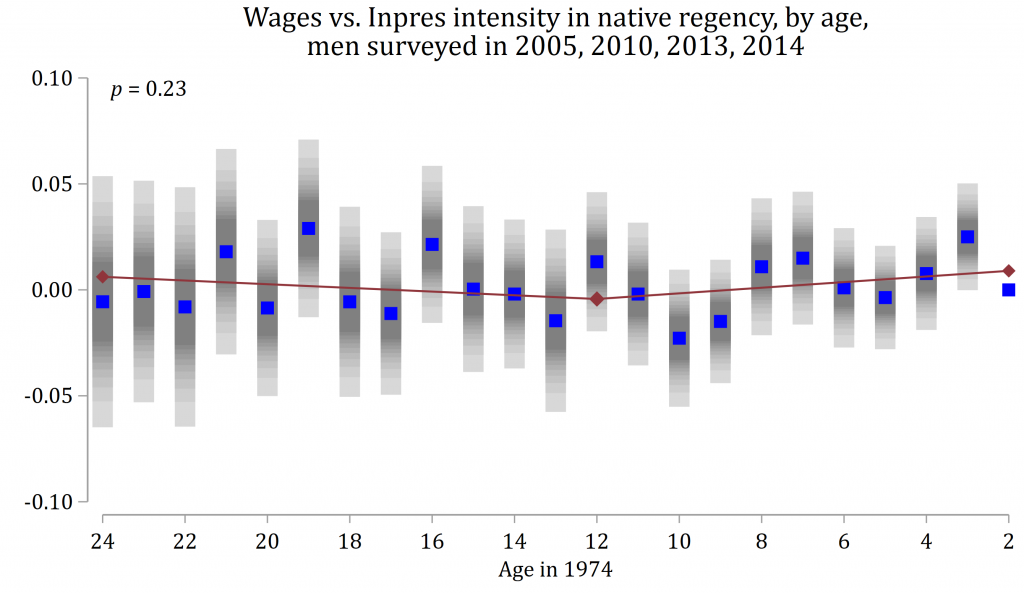
The red line bends upward, with a p-value of 0.23. I’m not one to mechanically dismiss a finding as “insignificant” when the p-value exceeds 0.05. At face value, p = 0.23 means there’s less than a 1-in-4 chance of a bend this big in the data if the true pattern is no bend at all. On the other hand, I could have put the finding to an even more rigorous test by including more of the control variables used in the Duflo study.[18]
Separately, I ran the changes-in-changes method I mentioned, the one that should be immune to wage scale dilation. This approach finds no wage boost from Inpres.
Conclusion
To recap:
- A representative result from the Duflo study is that Inpres-stimulated schooling increased future wages of boys by 7.5% per year of school, with a 95% confidence range of 1–15%.
- Technical adjustments widen that range hugely. The main reason is that it is surprisingly unclear whether the Inpres school construction led boys to go to school more. Dividing any wage increase by a number that cannot be confidently distinguished from zero makes for instability.
- It is more plausible that the program caused more boys to finish primary school.
- There’s another way to explain why the study finds that Inpres increased adult earnings. It is rooted in two facts: over their careers, more-educated people see their pay rise more (wage scale dilation); and poorer regencies got more schools per child.
- The changes-in-changes method, which is in effect designed to rule out wage scale dilation as an explanation, finds no wage boost from Inpres.
- On the other hand, an apparent fingerprint of Inpres, the trend bend, holds up fairly well in the wage data of 1995 despite my technical tweaks. And wage scale dilation would not be expected to cause such a bend.
- The fingerprint persists weakly later in life.
The findings reported here are important because they show that an unusually large government-administered intervention was effective in increasing both education and wages in Indonesia.
I am confident that, in retrospect, that reading is overconfident. But I wouldn’t swing to the opposite extreme of no confidence. It seems more likely than not that building all those schools (and hiring all those teachers) got more kids into school. And the big push may have left light fingerprints in the wage numbers decades later. Meanwhile, it is conceivable that the conservatism of the changes-in-changes method, which makes it less prone to generating false positives, also makes it more prone to generating false negatives.
Still, the rate of return to Inpres-stimulated schooling — wage gains per additional unit of schooling — is quite unclear.
One’s judgment about whether basic education in developing countries is a good thing should not hinge solely on the answers emerging from this study, nor even on the questions it asks. It could be that Inpres schools indeed made a large difference in Indonesia, but that the “natural experiment” was just not strong enough for the signal to shine through the noise. Or — more likely — the problem is that, as Lant Pritchett puts it, schooling ain’t learning. Maybe the Inpres schooling campaign was better at getting kids behind desks than knowledge into their heads. If billions of kids are passing through school and not learning much, there is huge room for improvement.
Moreover, higher pay is not the only reason to send kids to school. As I write, Duflo and coauthors are using randomly allocated scholarships in Ghana — an artificial rather than natural experiment — to research a wide array of potential consequences of secondary schooling, for girls as well as boys. Do the girls go on to have fewer unwanted pregnancies? Do fewer of their children die in the first year of life?
I am struck by how often the findings from studies of “natural experiments” fray under stress. An appreciation for that fact may explain why, soon after completing her dissertation, Esther Duflo became a champion of running actual experiments, such as the scholarship experiment in Ghana. Discarding some of what she learned in school would eventually pay high returns. It made Duflo the second woman to receive a Nobel prize in economics. And it drove her profession to produce more credible research.

